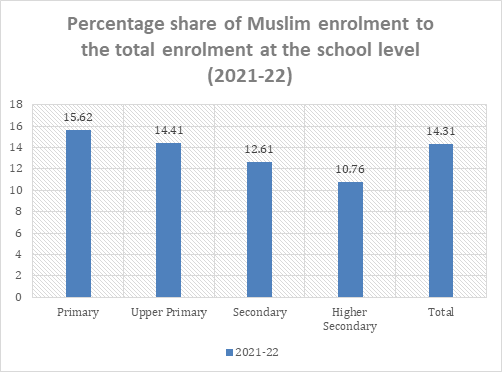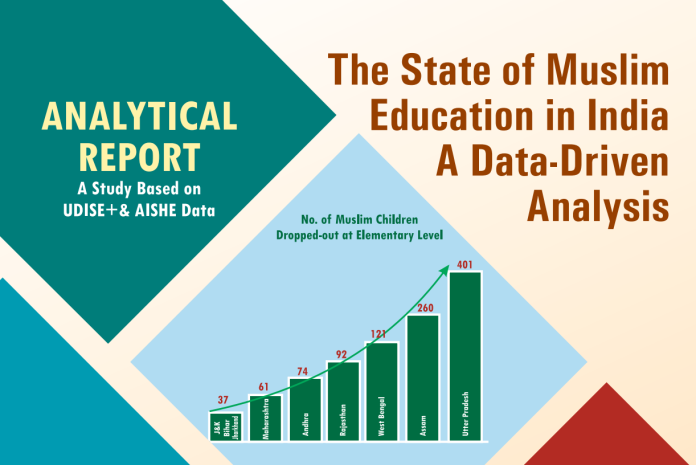
By Sadat Hussain
Recently a report on the status of Muslim education in India has been released, covering the education status of the Muslim community from school education to higher education. This report was drafted by Professor Arun C Mehta, a former professor at the National Institute of Educational Planning and Administration (NIEPA). This report created headlines. Some of the headlines were:
“Muslim students more likely to drop out at elementary level: UDISE Plus analysis”.
“Gender skew in schoolkids lower among Muslims: Data”
“Discrimination behind high ratio of Muslim students’ dropout at elementary level in India”
The report, which made the headlines, is known as ‘State of Muslim Education in India’. The report consists of 36 tables, 28 charts, and a further 35 tables in the annexure covering the aspects of population, school education, and higher education of Muslims in India.
The report used the following sources to compile and analyse the data:
- Census of India,
- National Sample Survey Organization (NSSO),
- National Family Health Surveys (NFHS),
- National Council of Applied Economic Research (NCAER),
- National Council of Educational Research and Training (NCERT), and
- National Institute of Educational Planning and Administration
Despite having multiple data sets on the various aspects of the development, still, the data sets on the Muslim question do not give a complete and holistic picture of the status of Muslims in education.
The author of the above-mentioned report reiterates the limitation of the report, “without data on the Muslim population across different segments of the education system, it becomes impossible to calculate enrolment ratios such as gross and net enrolment ratios, adjusted net enrolment ratios, and age-specific enrolment ratios. Unfortunately, the actual and projected population data for the Muslim population are not available beyond 2011, which is also the latest population data available for the total population in India. The 2021 Census is yet to be conducted.”
The report further added that “despite having Muslim enrolment data available since 2006-07 at various levels, such as block, district, state, and all-India levels, there has been a lack of in-depth analysis regarding the education of Muslim children. Crucial indicators, such as dropout, transition, and retention rates, have not been adequately explored. Therefore, the present article aims to shed light on the significant aspects that have not been sufficiently addressed and contribute to a better understanding of the status of Muslim education in India, which is lacking in the existing literature.”
The report sets the following recommendations about the education of the Muslim community:
School education:
- Steps should be taken to ensure that Muslim students get access to quality education,
- Providing scholarships to Muslim students,
- Availability of school infrastructure in Muslim concentration areas, and
- Recruiting more Muslim teachers.
Higher Education:
- Measures should be taken to address the low representation of Muslims in Higher Education.
- Providing special coaching and support to Muslim students preparing for competitive examinations.
In the coming days in detailed analysis and evaluation of the above recommendations shall be done.
The state of education of the Muslim community: School education:
Enrolment:
As per the latest UDISE Report 2021-22 of the Ministry of Education, Government of India, Muslims are 14.3% of the total enrolment from Primary to Higher Secondary. The major composition of 14.3 percent of students are under Primary with 52 percent followed by Upper Primary with 26.3 percent, Secondary with 13.3 percent and higher secondary with 8.4 percent. One can draw inferences that where the percentage of Muslims in the total enrolment declines with each increasing level of schooling, can be described as an educational disparity or educational inequality. This kind of disparity may be influenced by various factors, including socioeconomic conditions, cultural barriers, and systemic issues within the education system. This phenomenon can be observed in the below chart.

In the above chart, one can observe that the graph is declining from Primary to Higher secondary. At the primary level, the percentage is 15.62, which declines to 10.76 percent at the Higher secondary level. The report says, that “the participation of Muslim children at the secondary and higher secondary levels of education is much lower than at the all-India level, indicating that many of them do not continue and transit to the secondary level of education. The GER at these levels is lower, which suggests the need for targeted interventions to improve access and retention.”

The above chart (Chart 5 of the report) shows the share of Muslim students to total enrolment from class 9 to class 12 at all India levels in the last ten years from 2012-13 to 2021-22. The chart suggests that there is an increment in the enrolment of both girls and boys at the secondary level and higher secondary level. At secondary levels, Muslim girls’ participation has increased from 9.8 percent in 2012-13 to 13.4 percent in 2021-22 with an increase of 3.6 percent. The participation of Muslim boys was 8.4 percent during 2012-13 at the secondary level and increased to 11.9 percent in 2021-22. There has been a 3.5 percent growth in the enrolment rates of Muslim boys at the secondary level in the last ten years. Though the participation of Muslim girls at the secondary level is more than their Male counterpart, the growth percentage of both genders is almost at par with the minute difference of 0.1 percent.
At higher secondary level the percentage of enrolment for Muslim girls got increased from 7.6 percent in 2012-13 to 11.7 percent in 2021-22 with a growth of 4.1 percent. On the other hand, at the higher secondary level, the percentage enrolment of Muslim boys got increased from 6.7 percent in 2012-13 to 9.9 percent during 2021-22 with an increment of 3.2 percent. In this one can infer that the decadal growth of Muslim girls is 0.9 percent higher than the Muslim boys. This suggests that there is a positive trend among the parents to send their girl child to senior secondary schools.
Discussion
There is no doubt that Muslims are lagging in education. The positive from this report is at the school level the participation of Muslim girls is better than their male counterparts. From the Sachar Committee Report 2006 to this latest report on the state of Muslim education, the data tells a similar story where Muslims are lagging, but the pertinent questions are, why are Muslims lagging soon after completing the Upper Primary level of education? What are the key factors motivating Muslim children to continue their education for those who are continuing? What is the role of parents in the process of educational attainment/dropout of Muslim children? How far is the infrastructure available in the Minority Concentration blocks and districts to provide quality education?
To be continued…




